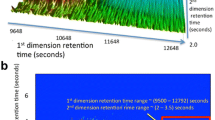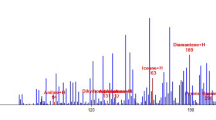Abstract
Tile-based Fisher ratio (F-ratio) analysis of comprehensive two-dimensional gas chromatography time-of-flight mass spectrometry (GC × GC-TOFMS) data is a powerful, supervised discovery methodology for pinpointing sample class-distinguishing analytes between two or more sample classes. Herein, we extend this analytical methodology to focus upon specific chemical groups in kerosene-based aerospace fuel using solid-phase extraction (SPE). Treating samples with SPE removes specific compounds depending on the SPE stationary phase (i.e., silica), creating an altered “pass” sample, identical to the original “neat” sample except for the extracted compounds. Application of F-ratio analysis to the neat samples against the pass samples provides global discovery with a numerically sorted hit list of all analytes affected by the SPE procedure. Sections of GC × GC-TOFMS data from the top analyte hits are reconstructed to form a “stitch” chromatogram to visualize the sample class-distinguishing compounds, revealing excellent agreement with the extract chromatogram. Additionally, utilizing the four-grid tiling scheme developed for tile-based F-ratio analysis, we demonstrate a tile-based pairwise analysis method, referred to as 1v1 analysis, to discover analytes that differ in concentration between two fuel chromatograms. Application of 1v1 analysis is highly efficient since replicates do not necessarily need to be run on the GC × GC-TOFMS instrument, which is beneficial for sample-limited applications. The 1v1 analyses discovered most of the same features as F-ratio analysis, ranging from 69 to 81% of the features discovered by F-ratio analysis while requiring one-sixth the data. Lastly, the overall methodology is applied to three candidate rocket fuels to better understand the compound class-distinguishing differences. The separate hit lists produced for high-concentration bulk hydrocarbon differences and low-concentration level polar compound differences provided valuable insight into these candidate rocket fuels.
Graphical abstract









Similar content being viewed by others
References
Cookson DJ, Latten JL, Shaw IM, Smith BE. Property-composition relationships for diesel and kerosene fuels. Fuel. 1985;64(4):509–19. https://doi.org/10.1016/0016-2361(85)90086-9.
Cookson DJ, Paul Lloyd C, Smith BE. Investigation of the chemical basis of diesel fuel properties. Energy Fuels. 1988;2(6):854–60. https://doi.org/10.1021/ef00012a021.
Cookson DJ, Iliopoulos P, Smith BE. Composition-property relations for jet and diesel fuels of variable boiling range. Fuel. 1995;74(1):70–8. https://doi.org/10.1016/0016-2361(94)P4333-W.
Bruno TJ, Huber ML, Lemmon EW. Effect of RP-1 compositional variability on thermophysical properties. Energy Fuels. 2009;23(11):5550–5. https://doi.org/10.1021/ef900597q.
Liu G, Wang L, Qu H, Shen H, Zhang X, Zhang S, et al. Artificial neural network approaches on composition-property relationships of jet fuels based on GC-MS. Fuel. 2007;86(16):2551–9. https://doi.org/10.1016/j.fuel.2007.02.023.
DeWitt MJ, Edwards T, Shafer L, Brooks D, Striebich R, Bagley SP, et al. Effect of aviation fuel type on pyrolytic reactivity and deposition propensity under supercritical conditions. Ind Eng Chem Res. 2011;50(18):10434–51. https://doi.org/10.1021/IE200257B.
Mallepally RR, Bamgbade BA, McHugh MA, Baled HO, Enick RM, Billingsley MC. Measurements and modeling of the density of rocket propellant RP-2 at temperatures to 573 K and pressures to 100 MPa. Fuel. 2019;1(253):1193–203. https://doi.org/10.1016/J.FUEL.2019.05.089.
Datschefski G. Role of the jftot in aviation fuel stability research. Fuel Sci Technol Int. 1988;6(6):609–31. https://doi.org/10.1080/08843758808915906.
Beaver B, Gao L, Burgess-Clifford C, Sobkowiak M. On the mechanisms of formation of thermal oxidative deposits in jet fuels. Are unified mechanisms possible for both storage and thermal oxidative deposit formation for middle distillate fuels? Energy and Fuels. 2005;19(4):1574–9. https://doi.org/10.1021/ef040090j.
Lee IC, Ubanyionwu HC. Determination of sulfur contaminants in military jet fuels. Fuel. 2008;87(3):312–8. https://doi.org/10.1016/J.FUEL.2007.05.010.
Alborzi E, Gadsby P, Ismail MS, Sheikhansari A, Dwyer MR, Meijer AJHM, et al. Comparative study of the effect of fuel deoxygenation and polar species removal on jet fuel surface deposition. Energy Fuels. 2019;33(3):1825–36. https://doi.org/10.1021/acs.energyfuels.8b03468.
Liu Z, Tang S, Li Z, Qin Z, Yuan S, Wang L, et al. An improved kinetic model for deposition by thermal oxidation of aviation hydrocarbon fuels. Fuel. 2019;15(258):116139. https://doi.org/10.1016/J.FUEL.2019.116139.
Paniv PM, Pysh’ev S V., Gaivanovich VI, Lazorko OI. Noncatalytic oxidation desulfurization of the kerosene cut. Chem Technol Fuels Oils. 2006;42(3):159–66. https://doi.org/10.1007/s10553-006-0049-4
Omais B, Courtiade M, Charon N, Thiébaut D, Quignard A, Hennion MC. Investigating comprehensive two-dimensional gas chromatography conditions to optimize the separation of oxygenated compounds in a direct coal liquefaction middle distillate. J Chromatogr A. 2011;1218(21):3233–40. https://doi.org/10.1016/J.CHROMA.2010.12.049.
Kehimkar B, Hoggard JC, Marney LC, Billingsley MC, Fraga CG, Bruno TJ, et al. Correlation of rocket propulsion fuel properties with chemical composition using comprehensive two-dimensional gas chromatography with time-of-flight mass spectrometry followed by partial least squares regression analysis. J Chromatogr A. 2014;31(1327):132–40. https://doi.org/10.1016/J.CHROMA.2013.12.060.
Jennerwein M, Eschner M, Wilharm T, Gröger T, Zimmermann R. Evaluation of reversed phase versus normal phase column combination for the quantitative analysis of common commercial available middle distillates using GC × GC-TOFMS and Visual Basic Script. Fuel. 2019;1(235):336–8. https://doi.org/10.1016/J.FUEL.2018.07.081.
Johnson KJ, Synovec RE. Pattern recognition of jet fuels: comprehensive GC × GC with ANOVA-based feature selection and principal component analysis. Chemom Intell Lab Syst. 2002;60(1–2):225–37. https://doi.org/10.1016/S0169-7439(01)00198-8.
Johnson KJ, Rose-Pehrsson SL, Morris RE. Characterization of fuel blends by GC-MS and multi-way chemometric tools. Pet Sci Technol. 2006;24(10):1175–86. https://doi.org/10.1081/LFT-200048192.
Bolotnik TA, Timchenko Y V., Plyushchenko I V., Levkina V V., Pirogov A V., Smolenkov AD, et al. Use of chemometric methods of data analysis for the identification and typification of petroleum and petroleum products. J Anal Chem 2019 7413. 2019;74(13):1336–40. https://doi.org/10.1134/S1061934819130045
Berrier KL, Freye CE, Billingsley MC, Synovec RE. Predictive modeling of aerospace fuel properties using comprehensive two-dimensional gas chromatography with time-of-flight mass spectrometry and partial least squares analysis. Energy Fuels. 2020;34(4):4084–94. https://doi.org/10.1021/acs.energyfuels.9b04108.
Parsons BA, Pinkerton DK, Wright BW, Synovec RE. Chemical characterization of the acid alteration of diesel fuel: non-targeted analysis by two-dimensional gas chromatography coupled with time-of-flight mass spectrometry with tile-based Fisher ratio and combinatorial threshold determination. J Chromatogr A. 2016;1(1440):179–90. https://doi.org/10.1016/j.chroma.2016.02.067.
Reaser BC, Wright BW, Synovec RE. Using receiver operating characteristic curves to optimize discovery-based software with comprehensive two-dimensional gas chromatography with time-of-flight mass spectrometry. Anal Chem. 2017;89(6):3606–12. https://doi.org/10.1021/acs.analchem.6b04991.
Parsons BA, Marney LC, Siegler WC, Hoggard JC, Wright BW, Synovec RE. Tile-based Fisher ratio analysis of comprehensive two-dimensional gas chromatography time-of-flight mass spectrometry (GC × GC-TOFMS) data using a null distribution approach. Anal Chem. 2015;87(7):3812–9. https://doi.org/10.1021/ac504472s.
Watson NE, Parsons BA, Synovec RE. Performance evaluation of tile-based Fisher ratio analysis using a benchmark yeast metabolome dataset. J Chromatogr A. 2016;12(1459):101–11. https://doi.org/10.1016/j.chroma.2016.06.067.
Stefanuto PH, Perrault KA, Dubois LM, L’Homme B, Allen C, Loughnane C, et al. Advanced method optimization for volatile aroma profiling of beer using two-dimensional gas chromatography time-of-flight mass spectrometry. J Chromatogr A. 2017;21(1507):45–52. https://doi.org/10.1016/j.chroma.2017.05.064.
Pesesse R, Stefanuto PH, Schleich F, Louis R, Focant JF. Multimodal chemometric approach for the analysis of human exhaled breath in lung cancer patients by TD-GC × GC-TOFMS. J Chromatogr B Anal Technol Biomed Life Sci. 2019;1(1114–1115):146–53. https://doi.org/10.1016/j.jchromb.2019.01.029.
Reichenbach SE, Zini CA, Nicolli KP, Welke JE, Cordero C, Tao Q. Benchmarking machine learning methods for comprehensive chemical fingerprinting and pattern recognition. J Chromatogr A. 2019;21(1595):158–67. https://doi.org/10.1016/j.chroma.2019.02.027.
Ochoa GS, Prebihalo SE, Reaser BC, Marney LC, Synovec RE. Statistical inference of mass channel purity from Fisher ratio analysis using comprehensive two-dimensional gas chromatography with time of flight mass spectrometry data. J Chromatogr A. 2020;13(1627):461401. https://doi.org/10.1016/j.chroma.2020.461401.
Sudol PE, Ochoa GS, Synovec RE. Investigation of the limit of discovery using tile-based Fisher ratio analysis with comprehensive two-dimensional gas chromatography time-of-flight mass spectrometry. J Chromatogr A. 2021;10(1644):462092. https://doi.org/10.1016/j.chroma.2021.462092.
Bennett B, Larter SR. Quantitative separation of aliphatic and aromatic hydrocarbons using silver ion-silica solid-phase extraction. Anal Chem. 2000;72(5):1039–44. https://doi.org/10.1021/ac9910482.
Balster LM, Zabarnick S, Striebich RC, Shafer LM, West ZJ. Analysis of polar species in jet fuel and determination of their role in autoxidative deposit formation. Energy Fuels. 2006;20(6):2564–71. https://doi.org/10.1021/ef060275l.
Striebich RC, Contreras J, Balster LM, West Z, Shafer LM, Zabarnick S. Identification of polar species in aviation fuels using multidimensional gas chromatography-time of flight mass spectrometry. Energy Fuels. 2009;23(11):5474–82. https://doi.org/10.1021/ef900386x.
Jones D, West CE, Scarlett AG, Frank RA, Rowland SJ. Isolation and estimation of the “aromatic” naphthenic acid content of an oil sands process-affected water extract. J Chromatogr A. 2012;20(1247):171–5. https://doi.org/10.1016/j.chroma.2012.05.073.
Lobodin VV, Robbins WK, Lu J, Rodgers RP. Separation and characterization of reactive and non-reactive sulfur in petroleum and its fractions. Energy and Fuels [Internet]. 2015;29(10):6177–86. https://doi.org/10.1021/acs.energyfuels.5b00780.
Mainali K, Garcia-Perez M. Identification and quantification of trace oxygenated compounds in alternative jet fuels: fluorescence methods for fast detection of phenolic compounds in operational field conditions. Fuel. 2020;1(271):117652. https://doi.org/10.1016/j.fuel.2020.117652.
Yuan S, Li H, Liu Z, Wang Y, Wang L, Zhang X, et al. Measurement of non-hindered and hindered phenolic species in aviation fuels via tandem-SPE with comprehensive GC × GC–MS/FID. Fuel. 2021;1(287):119561. https://doi.org/10.1016/j.fuel.2020.119561.
Cain CN, Trinklein TJ, Ochoa GS, Synovec RE. Tile-based pairwise analysis of GC × GC-TOFMS data to facilitate analyte discovery and mass spectrum purification. Anal Chem. 2022;94(14):5658–66. https://doi.org/10.1021/ACS.ANALCHEM.2C00223/ASSET/IMAGES/LARGE/AC2C00223_0008.JPEG.
Marney LC, Christopher Siegler W, Parsons BA, Hoggard JC, Wright BW, Synovec RE. Tile-based Fisher-ratio software for improved feature selection analysis of comprehensive two-dimensional gas chromatography-time-of-flight mass spectrometry data. Talanta. 2013;115:887–95. https://doi.org/10.1016/j.talanta.2013.06.038.
Prebihalo SE, Ochoa GS, Berrier KL, Skogerboe KJ, Cameron KL, Trump JR, et al. Control-normalized fisher ratio analysis of comprehensive two-dimensional gas chromatography time-of-flight mass spectrometry data for enhanced biomarker discovery in a metabolomic study of orthopedic knee-ligament injury. Anal Chem. 2020;92(23):15526–33. https://doi.org/10.1021/acs.analchem.0c03456.
Ochoa GS, Sudol PE, Trinklein TJ, Synovec RE. Class comparison enabled mass spectrum purification for comprehensive two-dimensional gas chromatography with time-of-flight mass spectrometry. Talanta. 2021;6:122844. https://doi.org/10.1016/J.TALANTA.2021.122844.
Cain CN, Schöneich S, Synovec RE. Development of an enhanced total ion current chromatogram algorithm to improve untargeted peak detection. Anal Chem [Internet]. 2020;92(16):11365–73. https://doi.org/10.1021/ACS.ANALCHEM.0C02136.
Acknowledgements
The work at the University of Washington was performed under subcontract to Jacobs Technology (RAPT1-0000000061), Air Force Research Laboratory, Edwards AFB, CA. Distribution Statement A: Approved for public release. Distribution is unlimited. AFRL-2022-3894. The fuels were provided by the Air Force Research Laboratory/RQRC, Edwards AFB, CA. Certain commercial equipment, instruments, or materials are identified in this paper in order to adequately specify the experimental procedure. Such identification does not imply recommendation or endorsement by the University of Washington or the US Air Force nor does it imply the materials or equipment identified are necessarily the best available for that purpose.
Author information
Authors and Affiliations
Corresponding author
Ethics declarations
Conflict of interest
The authors declare no competing interests.
Additional information
Publisher's note
Springer Nature remains neutral with regard to jurisdictional claims in published maps and institutional affiliations.
Published in the topical collection Comprehensive 2D Chromatography with guest editors Peter Q. Tranchida and Luigi Mondello.
Supplementary Information
Below is the link to the electronic supplementary material.
Rights and permissions
Springer Nature or its licensor holds exclusive rights to this article under a publishing agreement with the author(s) or other rightsholder(s); author self-archiving of the accepted manuscript version of this article is solely governed by the terms of such publishing agreement and applicable law.
About this article
Cite this article
Ochoa, G.S., Billingsley, M.C. & Synovec, R.E. Using solid-phase extraction to facilitate a focused tile-based Fisher ratio analysis of comprehensive two-dimensional gas chromatography time-of-flight mass spectrometry data: comparative analysis of aerospace fuel composition. Anal Bioanal Chem 415, 2411–2423 (2023). https://doi.org/10.1007/s00216-022-04348-1
Received:
Revised:
Accepted:
Published:
Issue Date:
DOI: https://doi.org/10.1007/s00216-022-04348-1




